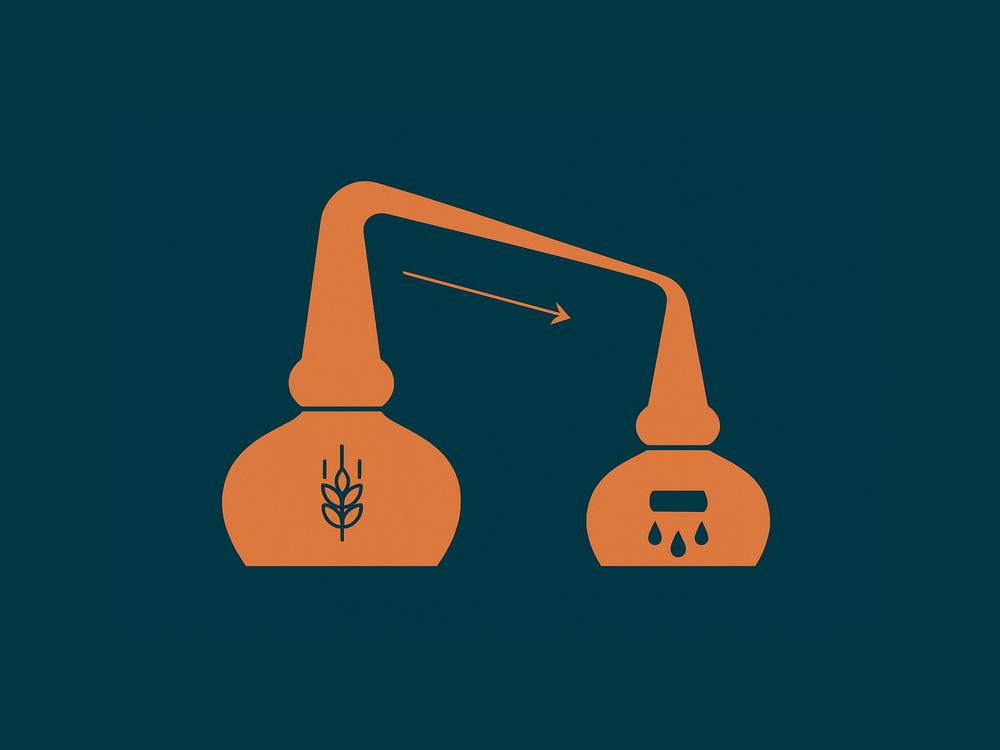TLDR
Double distillation
Double distillation runs wash to low wines, then low wines (plus recycled feints) to new make. It’s efficient, versatile, and-together with still design, cut points, condensers, and casks-defines the backbone style of most single malts.The Long Read
Published August 15, 2025
Contents

New to the basics of making whisky? Start with Whisky production, then see hardware primers on Pot stills, Condensors, and the Spirit safe. For contrasts, compare with Triple distillation, Mortlach’s selective triple stream in The Wee Witchie & 2.81, and plate columns under Continuous distillation and What is a Coffey still?.
What is double distillation?
In batch (pot-still) whisky-making, distillation sits between fermentation and maturation. A conventional double distillation has two main runs:
-
Wash still → low wines
Fermented wash (~7-10% ABV) is heated; alcohol-rich vapours rise, condense, and are collected as low wines (typically ~20-30% ABV). Spent wash (pot ale) remains in the pot. -
Spirit still → new make
Low wines are combined with selected feints (recycled tails and sometimes a portion of heads) and redistilled. The distiller uses the spirit safe to take cuts:- Foreshots/heads (early, solventy volatiles) → recycled
- Heart (cleanest window) → becomes new make (~68-72% ABV is common)
- Tails/feints (oily/heavy compounds as strength falls) → recycled
That heart is reduced to cask strength and filled for maturation.
Why two runs?
- Separation & control: The first run lifts alcohol and lighter volatiles out of the beer-like wash. The second run pinpoints the preferred flavour window via cut timing.
- Efficiency: Two passes balance energy/time costs with flavour fidelity. A third pass can lighten further (see Triple distillation), but isn’t required for clean spirit.
- Recycling loop: Returning feints to subsequent spirit charges smooths batch-to-batch variability and lets distillers “tune” weight and fruit.
Flavour: what double distillation tends to yield
Rules of thumb (not laws):
- Texture & weight: Compared with triple, double often retains more body (long-chain alcohols, waxes, heavier esters) - especially when paired with worm-tub condensation.
- Aromatics: From malty/cereal and orchard fruit through to wax, honey, sulphury/umami shades depending on cut width, fill strength, and cask choice.
- House style levers:
- Still geometry (height, neck taper, lyne-arm angle) alters reflux - see Pot stills.
- Condensation: Worm tubs (old-school coils) tend to give meatier, weightier spirit; shell-and-tube usually yields a cleaner profile - see Condensors.
- Cuts: Earlier heads and earlier tails cuts produce a lighter heart; pushing deeper broadens weight and complexity.
For a selective-triple twist inside a “double” framework, see Mortlach’s Wee Witchie configuration: The Wee Witchie & 2.81.
Double vs triple vs “2.81”
- Double (this page): two passes for the whole charge; heart ~68-72% ABV, widely used across Scotland.
- Triple: three passes for the whole charge (or equivalent routing), often a higher take-off strength (~78-82% ABV) and a lighter, citrus/ester-forward canvas - see Triple distillation. Examples include regular output from Auchentoshan and Hazelburn.
- Selective triple / Mortlach “2.81”: only a portion is triple-distilled in the Wee Witchie, then recombined, giving a weighted-average “2.81 times” and a meaty, worm-tub profile - see Wee Witchie & 2.81.
Process details that matter
- Charge composition: Ratio of low wines to feints determines starting strength and congeners in the spirit still.
- Heat input: Steam coil vs direct fire changes Maillard/singe effects and reflux behaviour.
- Cut strategy: Minute-by-minute decisions at the Spirit safe set house character more than the simple “two vs three” count.
- Cask alignment: Heavier double-distilled makes often suit sherry-seasoned oak; brighter makes shine in ex-bourbon. See intros to Oloroso sherry casks and Bourbon casks.
Misconceptions about distillation
- “Double is always heavy” - Not necessarily. Tall stills with high reflux, tight cuts, and shell-and-tube condensers can yield very elegant double-distilled spirit.
- “More distillations = better” - Style choice, not a quality ladder. Maturation and cask management will dominate the outcome.
FAQs
What ABV should I expect off the spirit still?
Many malt distilleries take the heart around ~70% ABV, but house targets vary.
Why recycle feints?
They carry desirable congeners that didn’t make the previous heart. Recycling also stabilises flavour over time.
How does this compare to column stills?
Columns separate continuously via plates and controlled reflux. See Continuous distillation and What is a Coffey still?.
See also
- Whisky production
- Pot stills • Condensors • Spirit safe
- Triple distillation • The Wee Witchie & 2.81
- Distillery examples: Auchentoshan • Hazelburn • Mortlach
Key takeaways
- Double distillation = wash still to low wines, spirit still to new make, with cuts and feints recycling.
- The two-pass regime is versatile and efficient, forming the default for most single malts.
- Style is set by choices: still geometry, condenser type, charge composition, heat profile, and cut timing - then casks do the heavy lifting in maturation.

